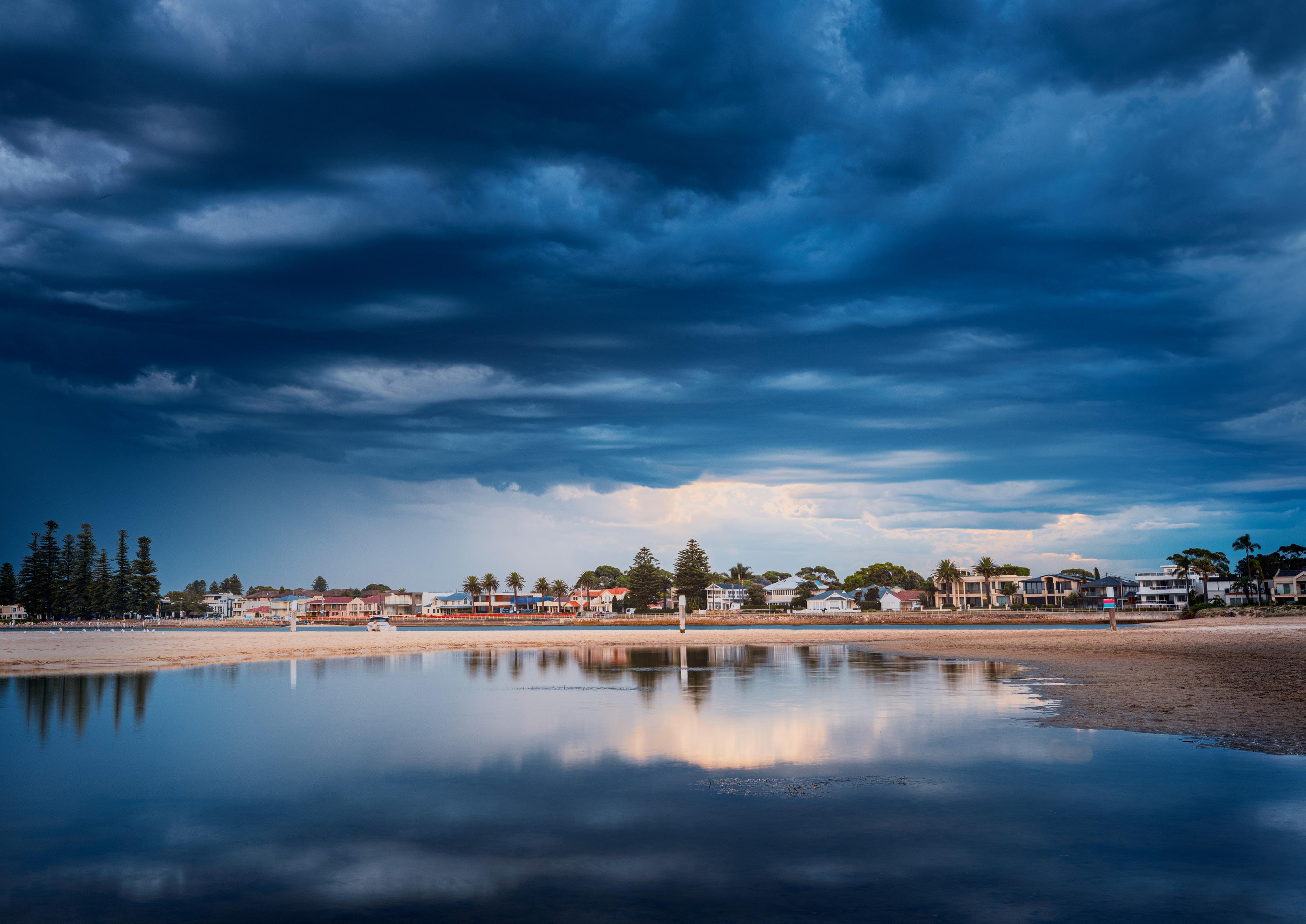2025–2035


Acknowledgement of Country
Bayside Council acknowledges the Bidjigal Clan, the traditional owners of the land on which we meet and work and acknowledges the Gadigal people of the Eora Nation. Bayside Council pays respects to Elders past and present.

Mayor’s Message
Bayside is a fantastic, vibrant and prosperous community, enriched by its diversity, making it an exceptional place to call home. I’m excited to present the Bayside Council Community Strategic Plan 2035 – a roadmap outlining our community’s vision and goals for the next decade.
First adopted in 2018, this Community Strategic Plan, which we are now reviewing, shapes the future direction of Council. It’s regularly updated with resident feedback to ensure we understand and meet the community’s expectations. The plan highlights our current position, outlines our aspirations and details the steps needed to achieve them.
One of my key priorities as Mayor is to enhance both passive and active open spaces. We recognise the profound impact that high quality open spaces have on our community, and I am committed to seeking out opportunities to expand and improve these vital assets.
Edward McDougall Mayor, Bayside Council
We must prioritise the protection of our open spaces and the stunning 8 kilometres of foreshore that defines our area. We need to invest in our local business strips, ensuring they remain viable, attractive and practical for our growing community. At the same time, we need to preserve our valuable community spaces and natural surroundings.
The review of our Community Strategic Plan gives us an opportunity to revitalise our local town centres, bringing new community spaces such as parks, community and cultural facilities, and reinvigorating the local area to benefit local residents, businesses and visitors to our community.
Over the past year, we’ve heard that you value a well planned city where sustainable development is prioritised, incorporating affordable housing and community facilities that cater to people of all ages and abilities. In reviewing our own plans and working closely with the State Government, this will be a key focus for this term of Council.
We’ve done a great deal as a Council to fight anti-social behaviour and car hooning through measures such as licence plate recognition cameras, traffic calming and practical deterrents, and I want us to continue to work closely with the Police Local Area Command and transport authorities to ensure we continue this work – we’re not going to solve these problems overnight, but it doesn’t mean we’re not making progress.
I extend my gratitude to everyone who participated and shared your feedback, priorities, and vision for Bayside at our various events and engagement sessions.
Together, we can make a meaningful difference.

What is a Community Strategic Plan?
The Bayside Council Community Strategic Plan (CSP) is our plan for the future. It describes how we will work towards a Bayside that we can all be proud to be part of in 2035. It is based on the aspirations and values our community has shared with us through extensive community engagement to develop the original Community Strategic Plan, to review and update the plan in 2022, and as part of its most recent review in 2024.
The plan acknowledges the Bayside area’s impact and affiliation with our neighbouring councils, connection to the broader Sydney metropolitan area, and partnerships with the NSW Government.
Our Community Strategic Plan will guide Bayside to meet the challenges and opportunities arising for the community as we move towards 2035. A pressing need for social, economic and environmental resilience, as well as emerging technologies, commercial activity, and population growth will require well planned responses by Council, State agencies, non-governmental organisations and the community.

The Bayside Community Strategic Plan sits at the top of Council’s planning framework and sets the strategic direction for Council’s Delivery Program and Operational Plans, as shown in the diagram. Together with our Long-Term Planning for Financial Management, Workforce Management and Asset Management, and land use planning through the Bayside Local Environmental Plan, it ensures that we have an effective and cohesive way forward.
The plan acknowledges the Bayside NSW Local Government Area, its affiliation with our neighbouring councils, connection to the broader Sydney Metropolitan area and partnerships with the State.
The themes, community outcomes, strategies and measures outlined in this plan will inform Council’s Delivery Program which sets the outcomes Council will work towards during the current term of office, and the annual Operational Plans that describe Council’s activities towards achieving those outcomes. The plan includes a measurement framework for each theme which will allow us to monitor progress towards achieving community outcomes.
It is important to remember that while Bayside Council is the custodian of Bayside on behalf of the community, it can’t deliver the outcomes of the Community Strategic Plan alone. This document is called a community plan because responsibility for its delivery lies with everyone –Council, other levels of government, businesses, community and not for profit organisations, and our residents.

How was the plan developed?
In developing Bayside 2035 Council undertook the following:
Extensive engagement with our community, businesses and other partners including through our Community Satisfaction Surveys in 2019, 2022, 2023 and 2024 to identify and explore community and stakeholder needs and aspirations
Demographic data and population forecasts
Relevant Council plans and strategies including:
Delivery Program, Operational Plan and Annual Report
— Local Strategic Planning Statement, Local Environment Plans, and Development Control Plan
Disability Inclusion Action Plan
Reconciliation Action Plan
Age Friendly Communities Strategy
Arts and Culture Strategy
Engagement and Communications Strategy
Resilience Strategy
Resourcing Strategy
Sustainable Waste Management Strategy
Transport Strategy
Urban Forest Strategy
Customer Experience Strategy
Regional, State and Australian government initiatives including:
Future Transport 2056
South East Sydney Transport Strategy
NSW Active Transport Strategy
Movement & Place Framework
NSW Budget (including the Performance and Wellbeing Framework)
— NSW Public Open Space Strategy
— Cultural Infrastructure Plan
24-Hour Economy Strategy
Smart Places Strategy, and Public Spaces Charter.
Sydney Airport’s upcoming Master Plan 2045, which will present the strategic direction for the Airport’s sustainable growth over the next 20 years.
The United Nations Sustainable Development Goals: Bayside’s Community Strategy Plan will contribute to the progress of the United Nations’ 17 ambitious Sustainable Development Goals, which the 193 member states of the UN, which includes Australia, are committed to. The Bayside community has made clear that sustainable development is important to them, which is why we are proud to align our local strategies to these global goals.
The key principles of Resilient Cities, Social Justice and Good Governance.

How did we engage with you?
1. Original Community Strategic Plan (2018)
Guided by Council’s Communications and Community Engagement Strategy, in 2018 we engaged Bayside residents across multiple platforms (including digital, print and phone) and held in-person events, to guide development of the original Community Strategic Plan.
To establish a plan that aligns with your vision, priorities, experience and ideas, we asked you:
What is Bayside like now?
What do you want Bayside to be like in 2030?
How are we going to get there?
How will we know we’ve arrived?
Council conducted a community satisfaction survey in 2019 that served as the original baseline for monitoring our progress on the Community Strategic Plan to 2024. Council’s progress on our Community Strategic Plan is reported in our Annual Reports, Operational Plan Six-Month Progress Reports and other publicly-available documentation.
2. Community Strategic Plan review and update (2022)
In 2022, we reviewed and updated the Community Strategic Plan. We invited the community to guide this refresh, reaching more than 3,000 people.
We updated the Community Strategic Plan based on how the community and Councillors responded to the following questions:
Do you agree with these long-term strategies for the next 10-20 years?
Do our visions, aspirations and goals determined in 2017/2018 still resonate?
Are our key focus areas still relevant to Bayside or do we need to readjust our focus?
We asked Councillors to share:
Which of the strategic directions under each theme do you believe are most relevant for Bayside’s future?
Is there anything missing from each theme?
What are your goals and aspirations for the coming term?
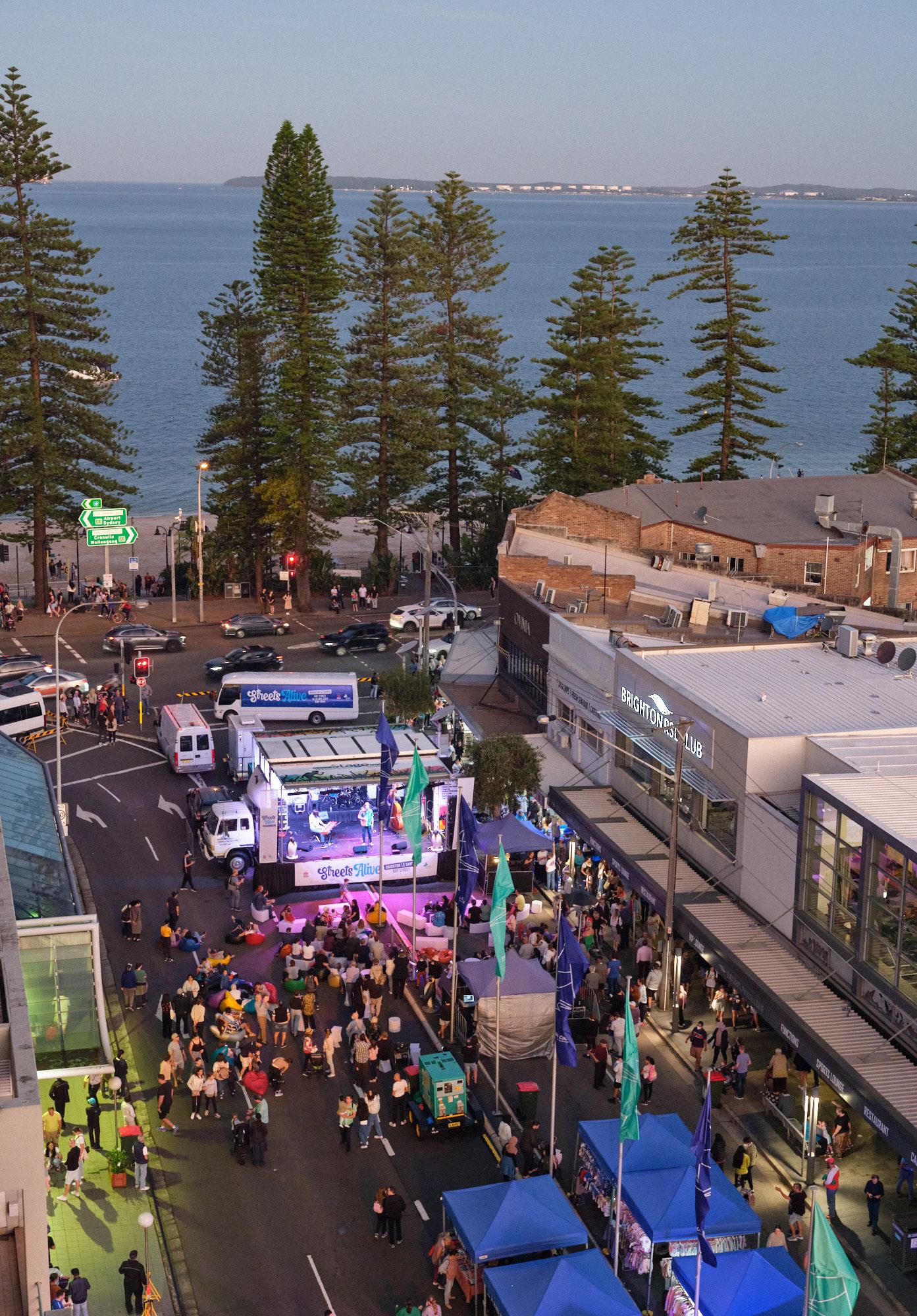
How did we engage with you?
3. Current review and update (2024)
PHONE SURVEYS
In September 2023 we conducted a community satisfaction survey of 601 households to assess:
The community’s overall level of satisfaction with Council performance and local quality of life.
Community priorities in relation to Council activities, services and facilities.
The community’s level of agreement with statements about living in Bayside.
The level of interaction between Council and residents, and community preferences about how we communicate.
The sample of 601 phone survey participants was weighted by age and gender to reflect the 2021 ABS Census data profile for Bayside. The phone survey participants were:
49% female and 51% male
age:

length of time living in the Bayside area:

Prompted by community responses to the 2023 survey, Council conducted two additional telephone surveys to better understand the key themes that emerged in response to the initial survey.
From December to January 2024, Council asked 137 members of the community about three key areas identified in 2023: affordable housing, communication and consultation, and willingness to pay for programs to address environmental protection and climate change.
Further to this, in August 2024, Council asked 401 members of the community to provide feedback on some of our priorities, to help us to target our actions appropriately. These questions focused on:
Responses to the four themes identified in the Community Strategic Plan.
Who people are thinking about when they express agreement with supporting ‘vulnerable members of the community,’ and what role they’d like to see Council take to support those community members.
What types of places people are thinking about when they express that they value ‘open space’ (e.g. sport fields, foreshores, trails), and what types of amenity are important to them as part of these places
What ‘planning for future sustainable growth’ means to different people, and what emerging priorities should be considered in the Community Strategic Plan to support this.
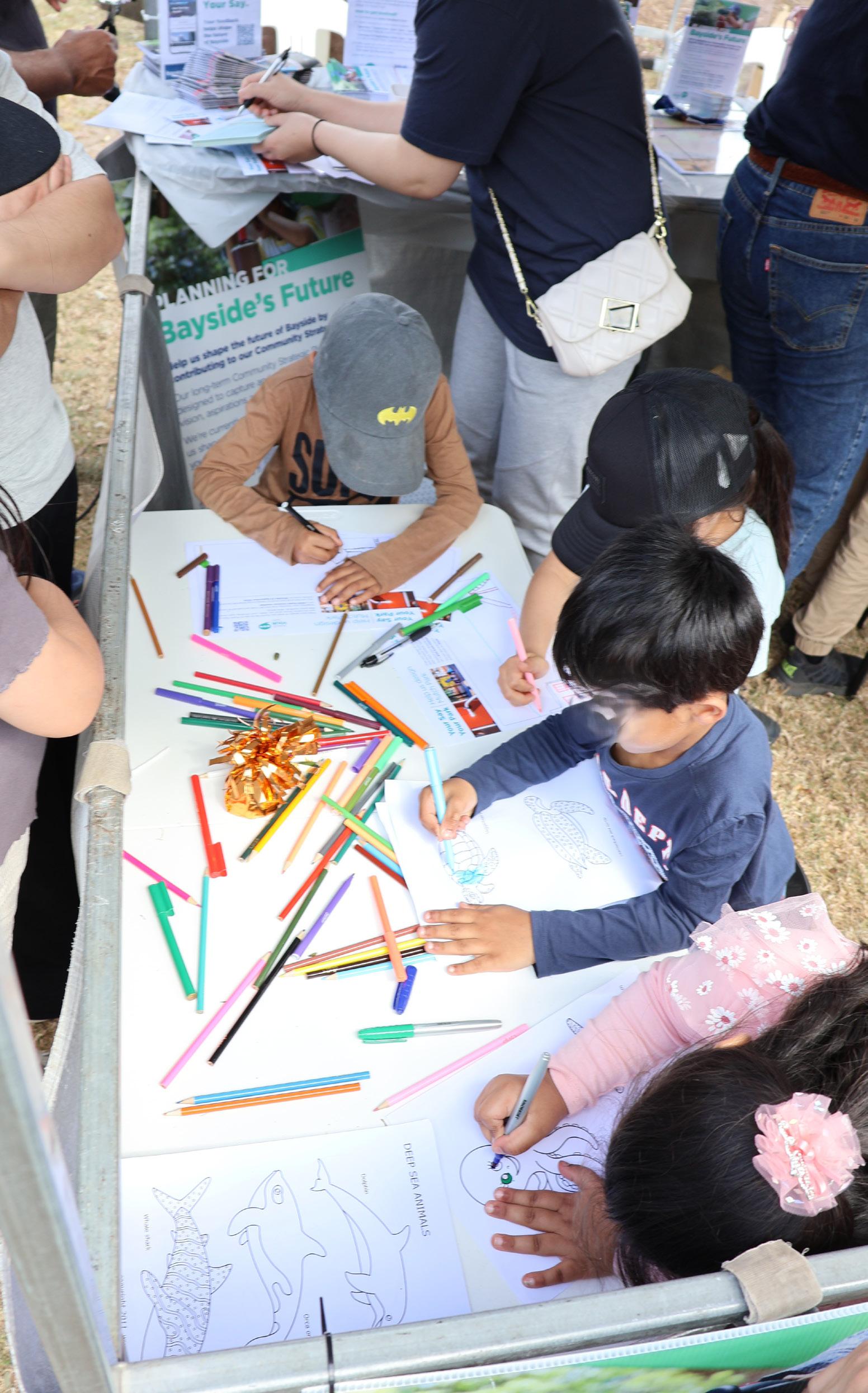
ONLINE AND IN-PERSON ENGAGEMENT
The community phone surveys were accompanied by open exhibition across two stages from September 2024 to February 2025, which included the following opportunities to have your say:
Have Your Say project page (2,375 page views)
Have Your Say survey (373 contributions)
Online Vison Board
(‘In 3 words, describe your ideal Bayside in 10 years’)
Quick Poll
(Have Your Say)
Youth Advisory Committee workshops
Pop up engagement sessions
Spring Fair
Jazz in the Mall
Migrant Information Day
Lunar New Year 2025
Our questions during these engagement activities aligned to the questions we asked in our 2023-2024 phone surveys, and included:
Rating overall satisfaction with Council’s progress on the community vision.
Rating the importance of each of the four themes identified in the Community Strategic Plan 2032.
Targeted questions about supporting vulnerable people, your use of open spaces, and defining sustainable development.
Whether new priorities have surfaced in recent years.
Describing your ideal Bayside in 10 years.
Opportunities to have your say were advertised through Council’s website, Bayside Council e-News, internal Inside Bayside, social media, and at our pop-ups.
Most respondents to the online community survey have lived in Bayside for more than 20 years (34%). largest age cohort of respondents was 35-44 years of age (29%). Of the people we heard from, 6.2% are Aboriginal or Torres Strait Islander, 10.17% have a disability, and 9% have a disability, and 20.4% speak a language other than English at home.
Participants’ inputs through these forums are reflected in the themes, outcomes, strategies and measurements detailed within this Community Strategic Plan. Your input across all community engagement during 2023 and 2024 is summarised in the following section ‘Your contribution to the plan.’
Lastly, a visioning workshop was held with the newly-elected Councillors. The Councillors’ aspirations are incorporated into the strategies across the four themes.
Your contribution to the Plan
Your feedback demonstrated the high level of importance placed by community members on Council being transparent in everything we do, and on managing sustainable growth and development in Bayside. We heard that:
In our comprehensive 2023 Community Satisfaction survey, we asked the community about Council services and facilities, interactions with Council, and quality of life in Bayside.
86% of survey respondents were at least somewhat satisfied with Council’s performance in the past 12 months, and 90% feel that their quality of life is “good” or “excellent.”
1. Future priorities
Through the phone and online surveys, workshops and in-person forums, you told us that your future priorities are:
1 Services and facilities (particularly to meet the needs of vulnerable community members)
2 Management of development
3 Resource recovery, recycling and waste management
4 Connectivity (particularly to increase active transport, manage traffic, and maintain our footpaths, roads and cycleways)
5 Protection of the environment, our waterways and open space.
“Acceptance of all individuals as they choose to be, using differences to bring vibrancy to the community... enhancement of nature and green spaces, safety and peace.”
Through a follow-up phone survey in August 2024, we heard more detail about what’s important to you. We heard that:
When considering vulnerable communities, it’s important that Council has a high level of involvement in supporting people who are experiencing domestic violence, people living with a disability, and older residents.
You value Bayside’s open spaces, and visit walking and cycling trails, parks, waterways and foreshore areas most frequently (three or more times per week). About a quarter of you also visit sports fields and ovals at least once a week.
Disability access in Bayside’s open space areas is even more important than public toilets (79% of respondents rating it ‘very important’ verses 75% for toilets).
Encouraging natural fauna and flora in our open spaces is important or very important for most community members (85%). Other experiential elements highlighted as being particularly important to you are heritage / historical signage (63%), outdoor education programs (63%) and walks on Country with Aboriginal elders (58%), ranked more highly than other initiatives like events, activations and outdoor gyms.
“Development must be on par with investment in green space and walking and cycle paths and playgrounds and toilets.”
“Protecting green space, affordable housing improvements, more childcare, more bike paths, more cultural celebration.”

2. Rating our facilities and services
How you rated importance and satisfaction with Council’s services and facilities has also guided the review of our strategic actions.
From Bayside’s 50 services and facilities, those identified as being most important to the community were:
public safety
road safety
recycling/waste management
litter control
quality of local roads and footpaths.
Thirty-one of Bayside’s 50 services and facilities received a “good performance” score.
Ten of the services and facilities (from a total of 18) that require “monitoring” by Council (meaning they have a lower community satisfaction score) involve the built environment – such as buildings and roads – as opposed to services like childcare and library programs. This is reflected in the community’s priority to manage development and improve connectivity.
Affordable housing was the only service/facility that received a satisfaction score that indicates it “needs improvement.” With Sydney’s population growing and housing in high demand, Council recognises the importance of strategic infrastructure planning, advocacy, and managing our services and facilities in a way that meets Bayside’s needs now and into the future.
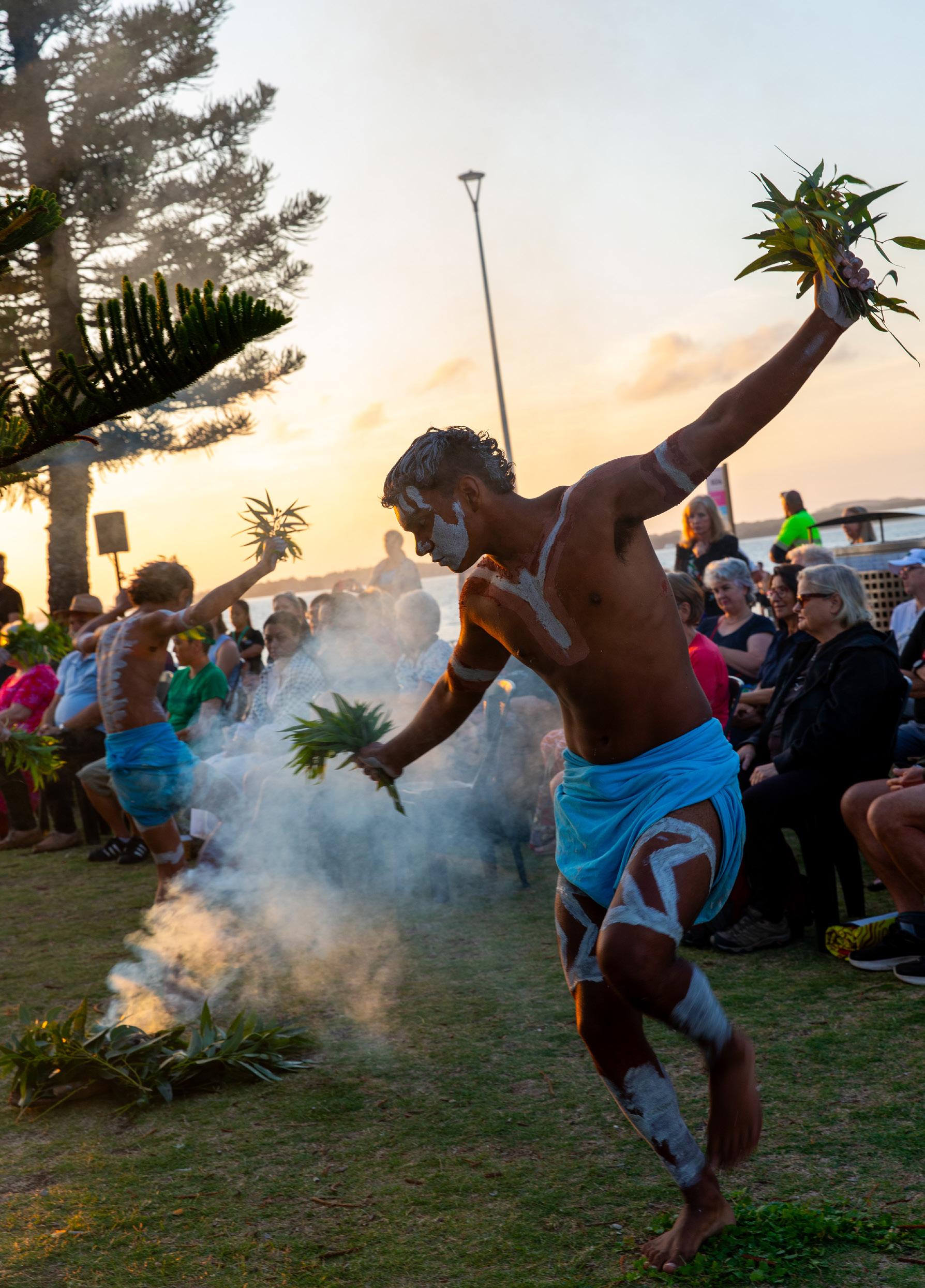
3. Interaction with Council
Nearly half of all community satisfaction survey respondents (48%) had contacted Council in the past two years, with residents aged 35-74 years more likely to do so. Sixty-nine percent of respondents were at least somewhat satisfied with the way their contact with Council was handled. What’s most important to you is that Council makes it clear what the next step is for resolving your query. On average, it takes 3.1 contacts with Council to get a query resolved.
4. Liveability
Your feedback on what makes Bayside a liveable place has remained largely consistent since 2018. Your responses indicate that community pride, support and feelings of safety are key contributors to what makes Bayside liveable, whereas a number of other elements detract from local liveability:
TOP 5
THINGS
THAT MAKE BAYSIDE A GREAT PLACE TO LIVE
I feel proud of where I live
I can call on a neighbour or local relative if I need assistance
5 THINGS THAT DON’T CONTRIBUTE WELL TO LIVEABILITY
I am aware of Council planning commitments and State Government plans
New developments are planned well and of a good design
I feel safe in Bayside
I feel safe using public facilities
Open space is available and cared for
Council adequately considers community concerns and views in making decisions
The local economy provides a wide range of work opportunities
Bayside is well prepared for extreme events
5. Performance gap analysis
A ‘performance gap analysis’ of the community survey results considers importance versus satisfaction. The greater the difference between community rated importance versus satisfaction, the greater Council’s focus will be on provision of that service, with a view to meeting community expectations. Refinements to the themes, strategies and measures outlined in this Plan respond to the largest gaps between community rated importance and performance. Specifically, this relates to:
1. Affordable housing
2. Traffic management
3. Quality of local roads
4. Road safety
5. Car parking
6. Litter control and illegal dumping
7. Quality of new developments
8. Quality of footpaths
9. Council decision making reflects community opinion.
The strategies outlined in this Community Strategic Plan have been updated to focus on narrowing the gap between importance and satisfaction ratings for these key service areas.
6. Our sustainable future
Community surveys have highlighted that planning for a sustainable future means different things to different people. Your inputs to this Plan have been essential for helping us to define that future. From our surveys we understand that, overall, it is extremely important that Bayside has:
a diversity of beautiful public spaces that offer places to relax and enjoy nature
a balanced allocation of well-maintained road space for different uses, enabling people to easily move around and access what they need
a high standard of design and inclusivity in our built environment
caring and transparent engagement with our community
innovation in terms of energy and resource use and disposal.
The community survey results summarised above have directly informed updates to the themes, strategies, and measurement frameworks within this Community Strategic Plan 2024.
“Equitable opportunities for all...an environmentally sustainable economy.”
“Uplifting the popular areas in Bayside especially around the Bay to invite and promote business.”
Community Vision
The community vision statement guides our Community Strategic Plan, from its themes and strategic actions to the way we measure progress towards these actions. The vision is based on what we’ve heard through engagement with the Bayside community. It aims to provide an overarching statement about community aspirations for Bayside in 2035.
Our community’s vision is that:
Bayside is a welcoming, safe, vibrant and sustainable. As members of the Bayside community we are proud to belong to a place that feels cared for, connected and creative. Bayside is built on trust, with engaged community members and effective leadership.
Our unique landscape, history and culture shape the way we live now and our future opportunities .

Guiding principles
Social justice principles
Social justice is recognition and action to support the rights of all people. All people have equal economic, social and cultural rights, regardless of gender, age, race, ethnicity, class, religion, disability or sexuality. Everyone should have the opportunity for personal development and be able to fully participate in society without discrimination.
This plan is guided by the fundamental social justice and sustainability principles:
Equity – there is fairness in decision-making, and prioritising and allocating resources, especially for those in need.
Access – there is fair access to services, resources and opportunities for people to improve their quality of life.
Rights are recognised and promoted. People from diverse cultural, religious and linguistic backgrounds can participate in community life.
People have fairer access to the economic resources and services essential to meet their basic needs and improve their quality of life.
Everyone has opportunities for genuine participation and consultation on decisions that affect their everyday lives.
Resilient cities principles
100 Resilient Cities (100RC) describes urban resilience as the capacity of individuals, communities, institutions, businesses, and systems within a city to survive, adapt, and grow no matter what kinds of chronic stresses and acute shocks it experiences. Bayside Council applies this framework to all of its medium and long term plans.
The processes that promote effective leadership, inclusive decision making, empowered stakeholders and integrated planning.
Everyone living and working in Bayside has access to what they need to survive and thrive.
The social and financial systems that enable urban populations to live peacefully, and act collectively.
The built and natural systems that provide critical services, protect and connect urban assets to enable the flow of goods, services, and knowledge.
Principles of good governance
Good governance is having the best possible processes for Bayside Council’s decision making. Council’s Good Governance Framework provides a single reference point for the policies, procedures and practices that outline how Bayside Council meets its governance commitments.
Accountability is a fundamental requirement of good governance. Local government has an obligation to report, explain and be answerable for the consequences of decisions it has made on behalf of the community it represents.
People should be able to follow and understand the decision-making process. This means that they will be able to clearly see how and why a decision was made –what information, advice and consultation council considered, and which legislative requirements (when relevant) council followed.
Local government should always try to serve the needs of the entire community while balancing competing interests in a timely, appropriate and responsive manner.
A community’s wellbeing results from all of its members feeling their interests have been considered by council in the decision-making process. This means that all groups, particularly the most vulnerable, should have opportunities to participate in the process.
Local government should implement decisions and follow processes that make the best use of the available people, resources and time to ensure the best possible results for their community.
Anyone affected by or interested in a decision should have the opportunity to participate in the process for making that decision. This can happen in several ways – community members may be provided with information, asked for their opinion, given the opportunity to make recommendations or, in some cases, be part of the actual decision-making process.


About Bayside
Our place
The Bayside Local Government Area extends from Bexley, Kingsgrove and Carlton in the west to Banksmeadow, Hillsdale, Pagewood, Daceyville and Rosebery in the east. It also encompasses Wolli Creek and Turrella in the north, Rockdale, Mascot, Botany, Sydney Airport and Port Botany down to the coastal communities of Brighton Le Sands, Ramsgate, Dolls Point and Sandringham in the south.
The Council has five wards, which are mapped at Figure 1.
Central to the area is the logistics hub of NSW. The area is of international significance as key infrastructure located within Bayside enables people to travel around the globe and to Australia. Goods arriving at our ports are transported around the country. Our local economy will mature as innovation and growth occurs as part of the State’s economy.
Bayside surrounds Kamay (Botany Bay) with eight kilometres of beach and parkland open for recreation to locals and visitors alike. Bayside Council has significant cultural and historical areas and acknowledges the ongoing connection to Country, culture and language of the many Aboriginal residents who live our area.
Bayside is well served with public transport with two main train lines and several busy bus routes.
Our significant wetlands provide important corridors for native flora and fauna, as well as places for our community to engage with natural surroundings.
Bayside Council provides significant sporting and recreation facilities, delivering access to a wide range of sporting clubs and associations.
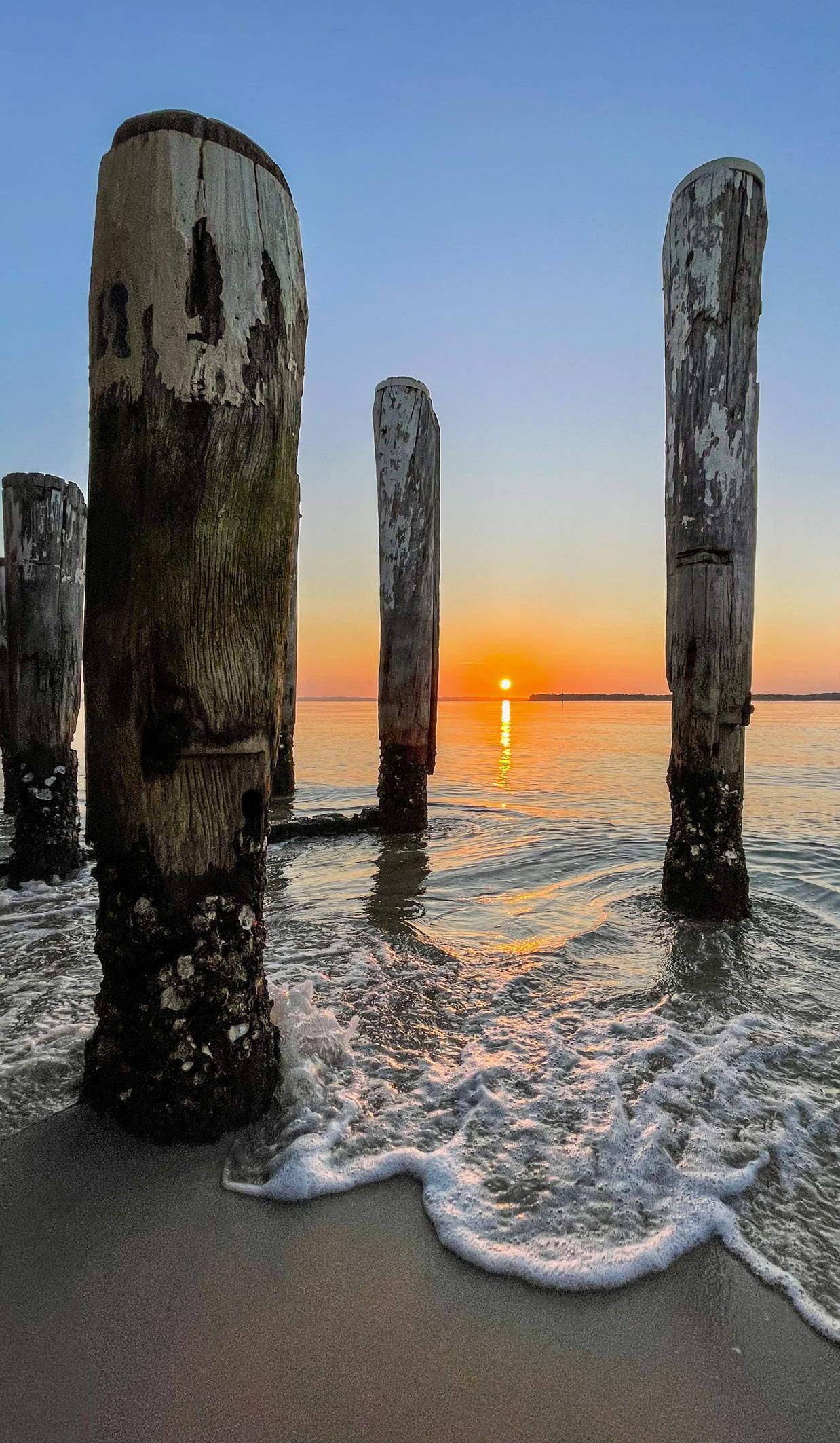
Our people
It is important that this Community Strategic Plan reflects both the Bayside community as it is now and how we expect our community to change as we move towards 2035.
BAYSIDE NOW
As of the 2021 Australian Bureau of Statistics census, Aboriginal and Torres Strait Islander people represented 1.1% of the Bayside population, in comparison to 3.4% across New South Wales. The Bayside community is diverse with 53.3% of the population born outside of Australia, and practising about 30 religions. China, Nepal, Indonesia, Greece and the Philippines were the most commonly identified countries of birth among Bayside residents born overseas. Chinese languages, Greek, Arabic and Spanish were the languages other than English most commonly spoken by members of the Bayside community.
Most common countries of birth (outside Australia)
Languages other than English spoken at home in Bayside
FUTURE POPULATION
As at the latest census (2021), 176,000 people were living in the Bayside LGA. By 2036 Bayside will be home to around 191,000 people, an increase of 15,000 persons (or approximately 8%) according to the 2022 NSW Common Planning Assumptions Projections.
In 2021 the dominant household type in Bayside was couple families with dependents (who made up 29% of all households). Couples with children are projected to remain the dominant household type in 2036 at 31% (Source 1). However, the greatest percentage increase is expected for ‘lone person’ households, with that cohort growing by approximately 23% by 2036.
Predicted population by age group and percent change to 2036
Forecast population and age groups to 2036 are shown below. While the 25-34 year old age bracket will still make up a large portion of Bayside’s population in the next ten years, we’ll also need to support a drastic growth in the proportion of people over the age of 75.
Percentage increase of household types by 2036
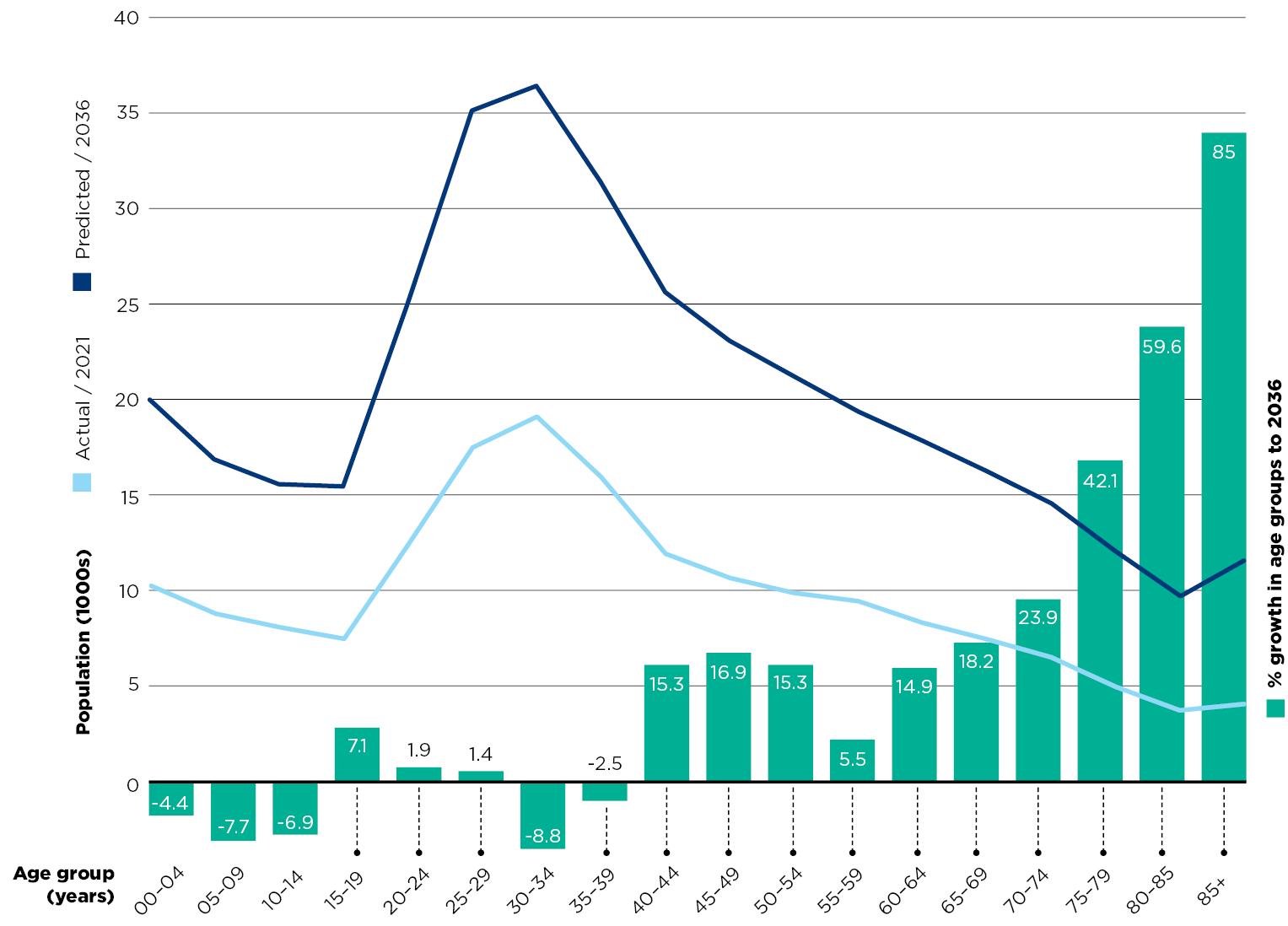
Notes: A ‘group’ household refers to people who are single and living with a group. A ‘lone person’ refers to those who are single and living alone.
Source 1: N SW Government Common Planning Assumptions (2022), https://www.planning.nsw.gov.au/research-and-demography/population-projections/explore-the-data
Related Plans
Bayside Council does not exist in isolation and we must consider the priorities of the State and Federal governments, local organisations and businesses and neighbouring councils. The modelling, research, strategic planning and expertise of these stakeholders together with the resources delivered to Bayside have a strong influence on our capacity to achieve the community’s aspirations.
The overarching state plans which guide our Community Strategic Plan are the Greater Sydney Region Plan, the 10-year NSW 2021 State Plan, and NSW housing targets.
Future state infrastructure projects
Bayside will be at the centre of significant works aimed at achieving the State Government’s objectives to plan for our future population. Various government agencies are involved in partnerships to achieve these outcomes. Transport projects including road enhancements, light rail, rapid bus links, and mass transit and rail projects are in planning. Additionally, a staged program of works over the next 10 years will deliver upgraded rail infrastructure, new trains and extra services across the suburban train network to address growth in patronage forecasts.


The Greater Sydney Region Plan –Eastern City
In 2017, the Greater Cities Commission established three distinct areas of Sydney to assist in visionary and strategic planning for the Greater Sydney region.
– Bayside falls within the Eastern City. Though the Commission itself has been dissolved, the ten directions for the Greater Sydney Region and the Eastern City continue to guide the NSW Government’s plans for Sydney’s sustainable growth, which are shown below. Bayside’s Community Strategic Plan reflects these directions, while tailoring our direction to our unique place and community.
Ten Directions for Greater Sydney and the Eastern City District
A city supported by infrastructure
A city for people
Housing the city
A city of great places
Jobs and skills for the city
A well-connected city
A city in its landscape
An efficient city
A resilient city
A collaborative city
The NSW 2021 State Plan (to 2031)
The Greater Sydney Region Plan’s ten directions support and align with the NSW 2021 State Plan and its five strategies, which are to:
1. Rebuild the economy
2. Return quality services
3. Renovate infrastructure
4. Strengthen our local environment and communities
5. Restore accountability to government.
NSW Housing Targets for Bayside Council
The NSW Government has committed to building 377,000 new well located, well designed and well-built homes across the state between 2024 and 2029. This target aligns with the National Housing Accord to help address the housing shortage in Australia. The housing targets identified for each council are based on planned and projected growth in that area. Planned growth reflects the number of homes in the pipeline for delivery with existing approvals, or rezonings that have already occurred. The housing targets also factor in projected growth, or the delivery of homes that can occur in the next five years based on the NSW Government’s planned reforms. The targets take into consideration existing infrastructure, ongoing investments and local constraints.
Bayside Council’s housing target is 10,100 new completed homes by 2029. These new homes will be developed, in line with the principles and outcomes of this Community Strategic Plan, to meet the needs of current and future residents in our welcoming, green, and connected Council area.
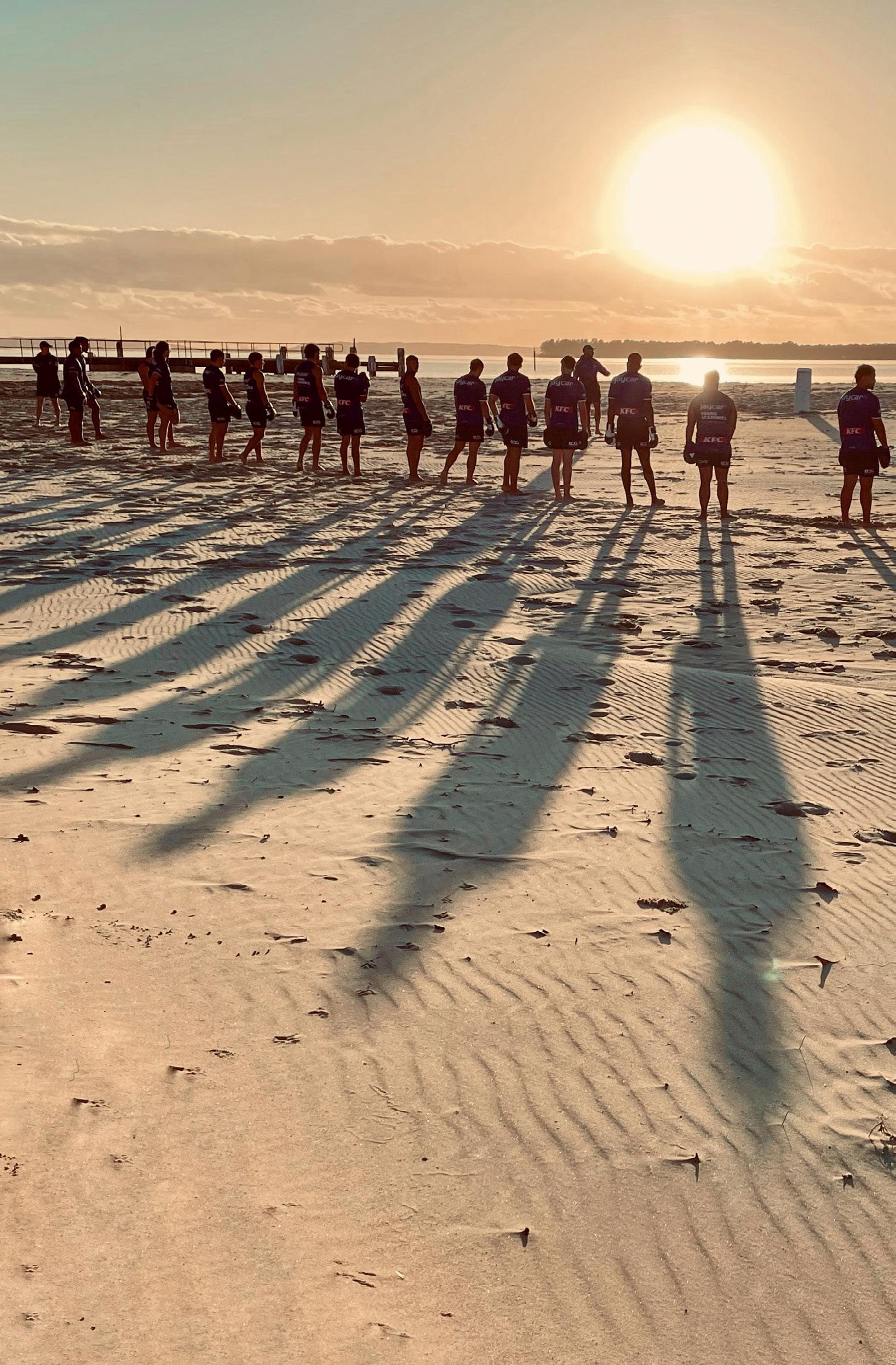
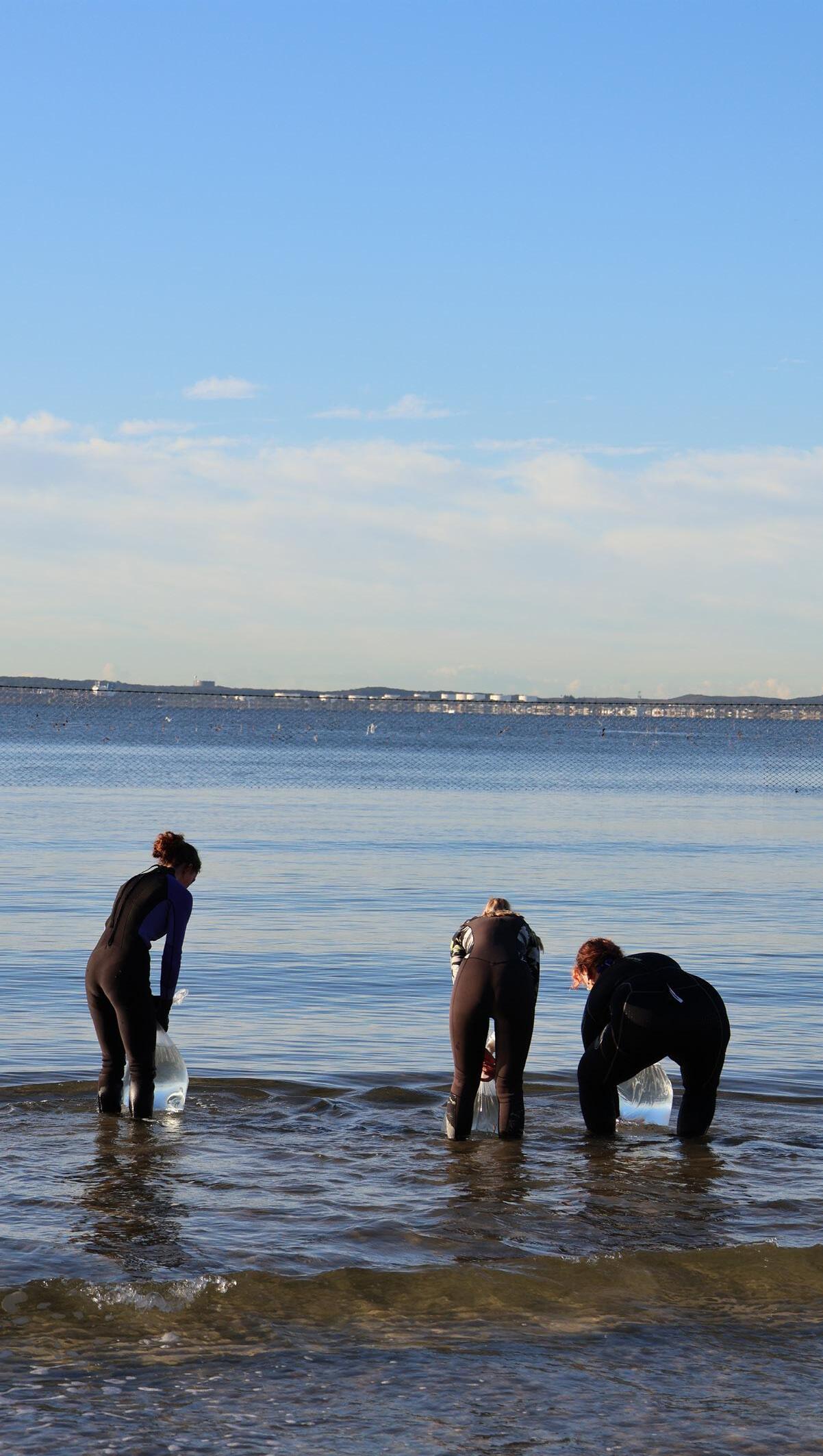
The plan
In 2018 Council developed the original Community Strategic Plan and four key themes to guide the future of Bayside, with key inputs from community and stakeholder engagement, forecasting, and review of relevant plans and principles. The Plan outlined community outcomes and targeted, actionable strategies to achieve them within each theme. A measurement framework was also developed for each theme, to monitor Council’s progress towards achieving community outcomes.
These elements have been reviewed and updated in response to the 2019, 2022, 2023 and 2024 community satisfaction survey results, which also serve as our measurement for success in delivering the Plan.
Council cannot deliver all of the community’s aspirations on our own. In some cases we need to partner with other agencies and organisations, in others we have an advocacy role –speaking up on behalf of the community and using the Community Strategic Plan to support that advocacy.
For some of the strategies we have identified opportunities for our community to partner with Council to deliver the outcomes they have identified as important to them.
For each strategy we have indicated what role Council can play in achieving the desired objectives. Council’s Delivery Program and Operational Plan details the four year activities and plans that Council undertakes to deliver on these strategies.
Within the measurement framework for each theme, we’ve identified the community satisfaction baseline results from the 2023/2024 financial year alongside our progress target for the trend we’d like to see by 2035.
By continuing to review and adjust our strategies in response to community feedback, and monitor our progress against specific measures, we aim to maintain and improve our community’s satisfaction and quality of life in Bayside.
Image: White’s Seahorse Release

Theme One
In 2035 Bayside will be a vibrant and liveable place
Neighbours, visitors and businesses connect in welcoming and beautiful urban environments. The built environment is thoughtfully-designed, sympathetic to the natural landscape, and offers places to live that are accessible for all.
COMMUNITY OUTCOMES STRATEGIES (Council’s role)
1.1 Bayside’s places are accessible to all
1.2 Bayside’s places are dynamic and connected
1.1.1 Create spaces, places and interactions that are safe and accessible (Deliver)
1.1.2 Improve availability of parking for those who need it, and kerbside lane uses that contribute to public space vibrancy (Deliver, Advocate)
1.1.3 Promote the provision of affordable housing (Partner, Advocate)
1.1.4 Maximise opportunities for safe, accessible, green open space with a range of active and passive recreation opportunities for all ages and abilities (Deliver, Partner)
f Community
f Council
f Developers
f NSW Police
f Sporting groups and associations
f State government agencies
1.3 Bayside’s places are people focussed
1.2.1 Create engaging, safe, walkable experiences that leverage green corridors across Bayside (Deliver, Advocate)
1.2.2 Ensure public buildings are well maintained as important community hubs with the opportunity for shared and multiple uses of facilities (Deliver, Advocate)
1.2.3 Facilitate greater connectivity to open space, schools, shops and services through active transport (Deliver, Partner, Advocate)
1.2.4 Support and deliver cultural and arts facilities, programs, events and opportunities (Deliver, Partner, Advocate)
1.3.1 Activate local areas and town centres with facilities valued by the community (Deliver, Partner)
1.3.2 Create and maintain vibrant, visually appealing and welcoming places with their own village atmosphere and sense of identity (Deliver, Partner, Advocate)
1.3.3 Promote innovative and well-designed local developments which incorporate open space and put people first (Deliver, Partner, Advocate)
1.3.4 Plan for growth and provide infrastructure that will serve our future population as well as our current needs (Deliver, Partner)
f Council
f Community
f Historical/heritage associations
f Local businesses
f Community
f Council
f Developers
f Local businesses
COMMUNITY OUTCOMES STRATEGIES (Council’s role)
1.4 Bayside’s transport system works
1.4.1 Promote adequate, accessible, reliable public transport for ease of travel to work and leisure (Advocate)
1.4.2 Improve opportunities for people to easily and safely choose to walk or ride to get where they need to go (Deliver, Advocate)
1.4.3 Maintain a high-quality, efficient local road network through investment in uplift that reduces traffic issues in Bayside (Deliver, Partner, Advocate)
1.4.4 Support NSW Police in their efforts to achieve zero trauma on our road network by 2050 in line with NSW targets (Deliver, Advocate) f Council f Transport for NSW f NSW Police
MEASUREMENT FRAMEWORK
Theme Two
In 2035 our Bayside community will be connected and feel that they belong
We have the resources and relationships we need to be active members of our community, adapt to change, support vulnerable people, take care of each other and effectively respond in times of adversity. Our strong connections help all of our diverse community members to feel valued.
2.1 Bayside celebrates and respects our diverse community
2.1.1 Reflect and celebrate cultural diversity in Bayside’s activities and events, which are accessible to people of all abilities” (Deliver, Partner)
2.1.2 Support events and creative expression that reflect and involve community (Deliver, Partner)
2.1.3 Promote opportunities for community members young and old to thrive in Bayside (Deliver, Partner)
2.1.4 Treat community members with dignity and respect (Deliver, Partner, Advocate)
f Aboriginal elders and organisations
f Community
f Council
f Historical/heritage associations
f Local businesses
f State government agencies
2.2 The community feels valued and supported
2.2.1 Leverage digital media and tools to provide accessible information and services anywhere at any time, providing clear avenues for action to resolve concerns (Deliver)
2.2.2 Provide opportunities for the community to engage and collaborate in Council’s decision-making, and provide information in a timely manner (Deliver)
2.2.3 Promote access to active recreation, health information and education services to support a healthy community (Deliver, Partner, Advocate)
2.2.4 Provide services and facilities that are safe, functional, vibrant and accessible for our diverse community, and that support volunteer engagement (Deliver, Advocate)
2.2.5 Progress action for the prevention of domestic, family and sexual violence to drive change, model best practice, respond to local concerns and lead the take-up of primary prevention activities in Council operations and through partnerships
2.2.6 Work with our partners to ensure flexible care/support arrangements for seniors, people with disabilities, and vulnerable community members (Partner, Advocate)
f Aboriginal elders and organisations
f Community
f Council
f Local Health District
f Schools
f Sporting groups and associations
f State government agencies
f Workplaces
COMMUNITY OUTCOMES STRATEGIES (Council’s role) WHO CAN HELP
2.3 The community is united and proud to live in Bayside
2.3.1 Develop and support community connections and networks which enhance resilience and reduce social isolation (Partner, Advocate)
2.3.2 Support community-led initiatives that encourage people to be more active in their local neighbourhood (Partner)
2.3.3 Encourage shared community objectives and desires (Deliver)
2.3.4 Foster a sense of community pride in and satisfaction with Bayside (Deliver, Partner, Advocate)
f Aboriginal elders and organisations
f Community
f Council
f South Eastern Sydney Local Health District
f Schools
f Sporting groups and associations
f State government agencies
MEASUREMENT FRAMEWORK
Theme Three
In 2035 Bayside will be green, resilient and sustainable
Our natural assets and biodiversity are protected and enhanced through collaborative partnerships to contribute to a healthy environment now and in the future. The community is resilient and confident in its ability to work together to thrive, adapt and recover from risks and climate events. Bayside strives to employ regenerative and circular practices in managing our use of energy, water and materials.
COMMUNITY OUTCOMES STRATEGIES (Council’s role)
3.1 Bayside is resilient to economic, social and environmental impacts
3.1.1 Build community capacity and resilience to prepare for, cope with, adapt to and recover from economic, social and environmental impacts (Deliver, Partner, Advocate)
3.1.2 Design, build and/or maintain Council infrastructure and natural assets to withstand and recover from disasters and disruptions (Deliver)
3.1.3 Provide educational tools about the local impacts of climate change to promote community awareness and agency (Deliver, Partner, Advocate)
3.1.4 Offer pathways for community to play a role in local climate and resilience leadership (Deliver, Advocate)
3.1.5 Engage with community to partner in an appropriate response to threats and adverse events (Deliver, Partner)
WHO CAN HELP
f Community
f Council
f Businesses
f State government agencies
f Commonwealth government agencies
3.2 Bayside is working toward a ‘net zero’ future
3.3 Bayside’s waterways and green corridors are regenerated and preserved
3.2.1 Reduce greenhouse gas emissions from Council’s operations to achieve net zero emissions while advocating for a city-wide net zero goal (Deliver, Advocate)
3.2.2 Facilitate the use of emerging transport technologies for more sustainable transportation and to meet the community’s changing needs (Partner, Advocate)
3.2.3 Promote the use of renewable energy through community education (Deliver, Partner, Advocate)
3.3.1 Expand Bayside’s carefully selected and well-maintained tree canopy (Deliver)
3.3.2 Involve community in the preservation and growth of natural habitat and biodiversity (Deliver, Partner)
3.3.3 Enhance and extend green grid corridors (Deliver, Partner, Advocate)
3.3.4 Recycle and re-use water where possible (Deliver)
3.3.5 Respect, manage and protect the natural environment, including our fragile coastlines (Deliver, Partner)
f Community
f Council
f Businesses
f State government agencies
f Community
f Council
f NSW Environmental Protection Authority (EPA)
f Volunteers
COMMUNITY OUTCOMES STRATEGIES (Council’s role)
3.4 B ayside’s waste to landfill is reduced year on year
3.4.1 Address illegal dumping proactively, offering accessible ways to direct waste to appropriate recovery streams (Deliver, Partner, Advocate)
3.4.2 Provide pathways for community involvement in Bayside’s circular economy: to reuse, reduce, repair and reprocess before recycling or disposing (Deliver, Partner)
3.4.3 D ecrease volume of waste to landfill through recycling, organics and other Council resource recovery programs (Deliver, Partner, Advocate) f Community f Council f Businesses f Strata bodies
MEASUREMENT FRAMEWORK
tonnes or approx. 48.6% of total domestic waste Annual rate of waste diverted from landfill (as supplied by independent processes) Increase to 65% diversion of domestic waste from landfill by 2032 Total volume of waste
Annual waste generation tonnage (supplied by various independent processes) divided by the estimated resident population forecast at the time
No increase on per capita basis (unless additional waste streams are introduced)
or increase
Theme Four
In 2035 Bayside will be financially sustainable and support a dynamic local economy
Botany Bay’s (Kamay’s) natural beauty, cultural heritage, and role as an international transport hub generates employment and supports a thriving, engaged community. Bayside’s employment centres are set within well-connected, flourishing urban spaces that attract businesses that contribute to the transition to a resilient, net zero economy. Council is sustainably managing its quadruple bottom line: social, environmental, economic and civic leadership.
4.1 Bayside generates diverse local employment and business opportunities
4.1.1 Encourage and support improved employment outcomes for First Nations peoples, Culturally and Linguistically Diverse community members and people living with a disability (Deliver, Partner, Advocate)
4.1.2 Monitor socio-economic outcomes in employment and work with partners to identify actions Council can support (Partner)
4.1.3 Support innovative businesses, including in the tourism and sustainability industries, to locate in Bayside (Partner, Advocate)
4.1.4 Encourage a vibrant nighttime economy that supports Bayside’s creative industries and contributes to safety at night (Deliver, Partner, Advocate)
4.2 Bayside supports a diverse and adaptive business community
4.2.1 Support local events and initiatives that leverage the cultural significance of Botany Bay (Kamay) to showcase Bayside’s unique natural and historical features (Deliver, Partner)
4.2.2 Review placemaking, active transport, and share-economy infrastructure in streetscape renewals, and support shop-local campaigns to assist local businesses (Deliver, Advocate)
4.2.3 Support businesses to transition to a net zero and circular economy (Partner)
4.2.4 Take advantage of Bayside’s position as an international hub for transport and logistics-related business (Advocate)
4.2.5 Preserve industrial lands and employment lands and partner with major employers to support local jobs and businesses (Deliver, Partner)
f Council
f Department of Planning and Environment
f Department of Education
f Aboriginal Affairs NSW
f Department of Communities and Justice
f Destination NSW
f Local businesses
f Business Enterprise Centre Australia (BEC)
f Council
f Department of Planning and Environment
f Local businesses
f NSW Ports
f Sydney Airport
COMMUNITY OUTCOMES STRATEGIES (Council’s role)
4.3 Council is financially sustainable and well governed
4.3.1 Ensure Council decision-making is transparent and data-driven (Deliver)
4.3.2 B uild confidence in Council’s use of technology through cybersecurity measures and transparent practices (Deliver, Partner)
4.3.3 Foster a customer-centric culture, providing excellent service at all touchpoints along the customer journey (Deliver)
4.3.4 Invest in a skilled and dynamic workforce to meet future challenges, meet accountability and compliance requirements, and deliver Council’s quadruple bottom line: social, environmental, economic and civic leadership (Deliver)
4.3.5 M anage Council assets (including digital) to meet community expectations within available resources (Deliver)
4.3.6 M anage Council finances for the long-term benefit of the community and to prioritise infrastructure funding commitments (Deliver)
MEASUREMENT FRAMEWORK
WHO CAN HELP
Council
or increase
Satisfaction Survey Maintain or increase
Level of agreement with the statement “the local economy provides a wide range of work opportunities”
Council performance against financial and asset management benchmarks contained in the annual Audited Financial Reports 2023 data 2022-2023 financial year results*
Maintain or increase
Improving on 4 of 6 financial measures**
Improvement on 3 of 4 asset management measures*** Socio-economic advantage and disadvantage
Index of Relative SocioEconomic Advantage and Disadvantage (IRSAD)
Maintain or increase
Bayside Customer Service Centres
Rockdale Library, 444-446 Princes Highway, Rockdale
Westfield Eastgardens, 152 Bunnerong Road, Eastgardens
Monday to Friday 8:30am – 4:30pm
Phone 1300 581 299 | 9562 1666
Email council@bayside.nsw.gov.au
Web www.bayside.nsw.gov.au
